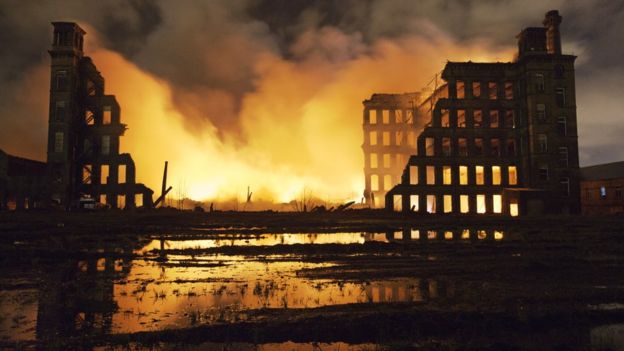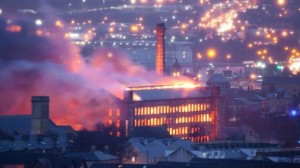
Drummond’s Mill Ablaze: Photo by Mark Davis, courtesy of http://www.bbc.co.uk/news/uk-england-leeds-35436802
By Benjamin Dunn
It was one of the most prominent landmarks in the inner city of Bradford, second only to the great chimney of Listers Mill in Manningham. Now it is no more. In the late morning of 28th January 2016 the enormous Drummonds Mill on Lumb Lane, Manningham perished in a ferociously powerful blaze. Up to 125 fire fighters from the city’s fire crews, and further afield in West Yorkshire attended the inferno. Emanating from the buildings’ vast basement which was at the time being used as a storage facility, the fire started at approximately 11.30am. By the afternoon it had spread to the rest of the Grade II listed, 1885 built, four story mill complex. It had been designed by the architects Lockwood and Mawson, the same firm responsible for the City Hall and many great Victorian buildings within the city.

Fire at Drummonds: Photo by Videl Velsmord courtesy of http://www.bbc.co.uk/news/uk-england-leeds-35436802
Residents of up to 100 nearby homes were evacuated to the Richard Dunn sports centre on the other side of the City at Odsal Top. By nine in the evening it was reported on the BBC News website that only 24 people had remained behind at the centre, with the rest assumed to have returned home or gone to stay with relatives in the city.
The mill has been owned most recently by Khalid Pervaiz who is managing director of Huddersfield-based KAS Property, and managed by Yasin Mohammed. Until recently Mr Mohammed had opened up a large part of the mill for tour groups who were taking part in the Making Their Mark Bradford Jewish tours, a regular occurrence during the spring and summer, run by local historian Nigel Grizzard. Sightseers would be taken round the mill to see the board room which housed a framed picture of the councillors of Bradford from 1910 – 1911, the year Bradford had its first Jewish Lord Mayor in Jacob Moser, with Moser positioned at the centre. Heritage trailers would then be taken to the weaving shed, an enormous open space with an apex of up to 30 ft, and be told about the mills history and its connections to the cities Jewish community. The mill had also been the location for a number of plays written by local playwrites, which had featured reviews in Newspapers including the Daily Telegraph. City of Dreams, which later lent it’s name to three part documentary television series on BBC Two. The video below is a prelude to a performance from 2011. In it can be seen the vast interior of the mills weaving shed. Another part of the mill resembled the hull of an upside down ship.

The Faces of 1911, with Jacob Moser, Lord Mayor centre. Photo courtesy of Councillor Ralph Berry on Twitter https://twitter.com/search?q=drummonds%20moser&src=typd
The mill was taken on by Rabbi’s son and WW1 veteran Ossie Stroud and his former wartime comrade, friend and business partner James Riley in the 1940s, after first being acquired by business magnates Solomon Selka and Berthold Reif after the Wall Street Crash of 1929.
According to the Bradford newspaper, the Telegraph & Argus of November 6th 1936, the epitome of Selka’s long and focussed career was the way he turned Drummond’s as a business around, during the Great Depression of the 1930s, “His successful rehabilitation of this extensive and old-established business, which during the period of severe depression had fallen into difficulties and was in danger of extinction, was the crowing achievement of of a remarkable career”.
One of the largest worsted spinning plants in Yorkshire Drummond’s directorship under Mr Selka prevented the loss of employment for over 800 people.
It remained within the hands of the Stroud family for two more generations, being passed onto Ossie’s son Roy and in turn on Roys son Richard. Richard Stroud, who began his textile career as a sales agent, flying across the globe to broker deals with Americans and in the far East would run it with Bradford businessman Stefan Simmonds. He himself had begun a career in retail at Marks and Spencer, before opening his first shop, a hugely successful discount store, Super Simon on James Street in Bradford’s commercial centre during the late 1960s. Stroud and Simmonds would be the last to run the textile mill, famed for its Worsteds, which would close it’s doors in 2001, after an eventful 115 years of manufacturing history. The mill then passed into the grasp of current owner and occupier, Mr Pervaiz, who now has the head ache of deciding what to do with the ginormous ruin.
This is the end of an era for one of Bradford most iconic, and recognisable industrial colossus’s. Alas, all of this is no more. Gone in an instant.

